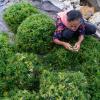
A team of researchers investigated whether seaweed offers a sustainable alternative to land-based agricultural expansion to meet the world’s growing need for food and materials.
“Seaweed holds considerable promise both commercially and environmentally, serving as a nutritious food and key ingredient in various products,” notes Scott Spillias, an alumnus of the Young Scientists Summer Program. “We found that expanding seaweed farming could help reduce demand for crops on land and reduce global agricultural greenhouse gas (GHG) emissions by up to 2.6 billion tonnes of CO2-equivalent per year.”
Spillias collaborated with researchers from the University of Queensland, IIASA, CSIRO, and the University of Tasmania. The team mapped the potential of farming more of the 34 commercially important seaweed species using the IIASA Global Biosphere Management Model (GLOBIOM). They estimated the environmental benefits of a range of scenarios based on land-use changes, GHG emissions, and projected changes in species presence by 2050.
The researchers suggest that substituting 10% of global diets with seaweed products could spare 110 million hectares of land from farming development. They also identified vast ocean areas within exclusive economic zones (EEZs) as promising locations for seaweed farming.
“This study highlights the need for strategies bringing together terrestrial and marine ecosystems management to address some of the problems of global sustainability, as well as to avoid displacing problems from the land to the ocean, and vice versa,” concludes IIASA Biodiversity and Natural Resources Program Director, Petr Havlík.
Further info:
Spillias, S., Valin, H. , Batka, M. , Sperling, F., Havlik, P. , Leclere, D., Cottrell, R.S., O’Brien, K.R., & McDonald-Madden, E. (2023). Reducing global land-use pressures with seaweed farming. Nature Sustainability 6 380-390. 10.1038/s41893-022-01043-y.
